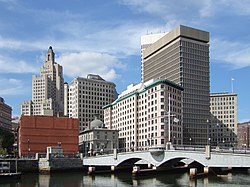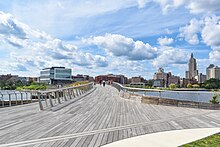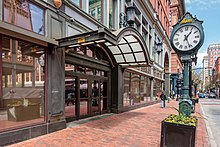Downtown, Providence, Rhode Island
This article needs additional citations for verification. (July 2016) |
Downtown Providence Historic District | |
 | |
 | |
| Location | Providence, Rhode Island |
|---|---|
| Coordinates | 41°49′N 71°25′W / 41.82°N 71.41°WCoordinates: 41°49′N 71°25′W / 41.82°N 71.41°W |
| Area | 90 acres (36 ha) |
| Built | 1800 |
| Architectural style | Late 19th And Early 20th Century American Movements, Late Victorian |
| NRHP reference No. | 84001967[1] (original) 07001081 (increase 1) 12000438 (increase 2) |
| Significant dates | |
| Added to NRHP | February 10, 1984 |
| Boundary increases | October 11, 2007 July 25, 2012 |
Downtown is the central economic, political, and cultural district of the city of Providence, Rhode Island. It is bounded on the east by Canal Street and the Providence River, to the north by Smith Street, to the west by Interstate 95, and to the south by Henderson Street. I-95 serves as a physical barrier between the city's commercial core and neighborhoods of Federal Hill, West End, and Upper South Providence. Most of the downtown is listed on the National Register of Historic Places as the Downtown Providence Historic District.

History[]
Originally known as 'Weybossett Neck' or 'Weybossett Side,' Downtown was first settled by religious dissidents from the First Congregational Society in 1746. Their settlement was located near present-day Westminster Street.[2]
Downtown did not witness substantial development until the early 19th century, when Providence began to compete with Newport, Rhode Island. British forces had destroyed much of Newport during the American War for Independence, making the city's merchants vulnerable to competition from Providence.[2] This prevented the development of a commercial district along the western bank of the Providence River.
Interstate highways[]
Starting in 1956, construction began on Interstate 195 and Interstate 95.[3][4] The routes of these highways took them directly through several established Providence neighborhoods. Over the next several years hundreds of homes and businesses and two churches are demolished.[5] The highways disconnected Downtown from South Providence, the West End, Federal Hill, and Smith Hill neighborhoods, leaving the city forever divided.[5][3][4]
Decline: 1960s and 1970s[]
Providence's population declined from a peak of 253,504 in 1940 to only 179,213 in 1970.[5] The white middle class moved away from the city center, and businesses followed.[5] A downtown address no longer conveyed prestige.[5] By 1970, downtown was widely seen as a dangerous place to be after dark, lacked sufficient parking, and most shopping and movie-going moved to the suburbs.[5] A 1961 master plan called Downtown 1970 didn't help matters much, recommending massive bulldozing of properties.[5] As hotels and stores were abandoned, Johnson and Wales University purchased many of the vacant properties.[5]
In 1964, Westminster Street was converted to the pedestrianized "Westminster Mall," in an attempt to create a pleasant shopping environment downtown.[5] It was unable to attract shoppers away from the new suburban Midland Mall (1968) and Warwick Mall (1972).[5] Within a decade, all the street's major department stores had closed except Woolworth's, and in 1989 the mall was torn up and the street returned to vehicular traffic.[5]
Remaking downtown[]
During the industrialization of the late 19th century, an ever-expanding railroad industry emanating from Union Station, eventually resulted in the complete paving over of the Great Salt Cove and the two branches of the Providence River.[6] The result of decades of expansion was the isolation of the state capitol from the rest of downtown by an imposing mass of railroad tracks, often called locally the "Chinese Wall".[7] As rail traffic dropped off, 75 percent by 1980,[8] city planners saw an opportunity to open up central land for development and unify downtown with the Capitol. A new, smaller train station was built in 1986 a half mile north of its predecessor, and tracks were removed or routed underground.
The new land precipitated a massive remaking of the character of the city's downtown. From 1975 until 1982, under Mayor Vincent Cianci, Jr, $606 million of local and national Community Development funds from were invested. Roads were removed and the city's natural rivers were opened up and lined with a cobblestone-paved park called Waterplace Park in 1994, which is now host to popular WaterFire festivals.[9] Private and public developments followed and the new area adjacent to the Capitol became known as Capitol Center.[10]
Ushered in by the construction of the new train station (1986), the development of the new land brought new buildings: The Gateway Building (1990), One Citizens Plaza (1991), Center Place (1992), a Westin hotel and Providence Convention Center (1993), Providence Place Mall (1999), Courtyard Marriott (2000), GTECH headquarters (2006), (2007), Waterplace Towers condominiums (2007), and Capitol Cove still under construction.
In 2007, the Renaissance Providence Hotel opened in Masonic Temple building, which had been abandoned amidst the Great Depression a half century prior.[11]

The relocation of Interstate 195 (the "Iway" project) in the early 2000s sparked another boom of construction in the 2010s, including the Michael S. Van Leesten Memorial Bridge, which spans the Providence River, and the Point 225 building in 2019[12] (aka "Wexford Innovation Center"), designed by Ayers Saint Gross,[13] and a riverfront park. Several other buildings in the area are under construction or proposed.[14]
Demographics[]
According to the Providence Plan, a local nonprofit aimed at improving city life, 64% of residents are white and 8.6% are Asian, both above the citywide averages of 54.4% and 6.2% respectively. 12% of the population is African-American, 11% is Hispanic, and 1% is Native American. 43% of public school children speak a language other than English as their primary language.[15]
The median family income is $42,558, over $10,000 above the citywide average. 14% of families live below the poverty line while nearly 3.7% receive some form of public assistance.[15]
15% of children under the age of six have been exposed to high quantities of lead.[15]
Government[]
From north to south, Downtown includes portions of Wards 12, 13, 11. These wards are represented in the Providence City Council by Kat Kerwin, John J. Lombardi, and Balbina A. Young.[16] All three councillors are Democrats.
Providence City Hall is located at 25 Dorrance Street, at the corner of Dorrance and Washington Street. It is immediately next to Kennedy Plaza and the Biltmore Hotel. It houses the City Council, the Mayor's Office, and the offices of some municipal agencies.
The Rhode Island State House is located on Smith Street at the northern edge of Downtown. It includes the chambers of the Rhode Island General Assembly and the Governor's Office.
The Rhode Island Department of Education is headquartered in the Shepard Company Building at 255 Westminster Street.[17]
Universities[]

Various universities have facilities in Downtown Providence. These include:
- Brown University has recently bought several properties in the Jewelry District.
- Johnson & Wales University has its central and largest campus in Downtown. This campus includes Johnson & Wales School of Business, School of Technology, College of Arts and Science and School of Hospitality.[18]
- The Rhode Island School of Design (RISD), though centered along the western slope of College Hill, has extensive facilities in Downtown. These include the RISD Library, founded in 1878. It is located at 15 Westminster Street.[19]
- Roger Williams University includes a small campus in Downtown.[20]
- The University of Rhode Island's Feinstein Providence campus is centered at 80 Washington Street with other facilities in the Shepard Building. The program is named for Rhode Island philanthropist Alan Shawn Feinstein.[21]
Sports[]

The Providence Bruins of the American Hockey League and the Providence College Friars men's basketball team play out of the Dunkin' Donuts Center (formerly the Providence Civic Center) at 1 LaSalle Square.[22]
Arts[]
As part of the revitalization of Providence, the administrations of Mayors Vincent Cianci and David Cicilline have promoted Providence, especially its Downcity Arts District, as an artistic center. WaterFire has become perhaps the most visible symbol of Providence's development into an artistic center. Waterfire is an environmental art event created by Barnaby Evans that includes bon fires, gondolas, and music. This event has become a major attraction for both Rhode Islanders and tourists.
The Downcity Arts District includes two centers for the performing arts, the Providence Performing Arts Center and Trinity Repertory Company.[23][24]
The Downcity Arts District is also home to AS220, a non-profit community arts center that includes fifty-three artist live/work studios, four galleries, a performance space, a black box theatre, a dance studio, a bar and restaurant, a makerspace consisting of a printshop, fab lab, media arts lab and darkroom, and a free after-school arts education program for youth.
Architecture[]
Downtown Providence has numerous 19th-century mercantile buildings in the Federal and Victorian architectural styles, as well as several post-modern and modernist buildings that are located throughout this area. In particular, a fairly clear spatial separation appears between the areas of pre-1980s development and post-1980s development. Fountain Street and Exchange Terrace serve as rough boundaries between the two.
Parks[]
Downtown Providence contains numerous parks:
- Burnside Park is located adjacent to Kennedy Plaza. At its center is an equestrian statue of American Civil War general, Rhode Island governor, United States Senator Ambrose Burnside. Adjacent to the park is an outdoor ice skating rink, the Alex and Ani City Center.
- Waterplace Park extends from the Great Salt Cove to the Riverwalk along the Providence River. The park hosts WaterFire festivals.
- Station Park, a green space adjacent to the Providence Amtrak Station.[25]
In addition, Veterans Memorial Park and Market Square, along the border between Downtown and College Hill, are sometimes counted as Downtown parks.
Central Downtown[]

The historic part of downtown has many streetscapes that look as they did eighty years ago. Most of the state's tallest buildings are found in this area. The largest structure, to date, is the art-deco-styled Industrial National Bank Building (commonly called the "Superman Building"), at 426 feet (130 m).[26] By contrast, nearby to it is the second tallest One Financial Center (Sovereign Bank Tower), designed in modern taut-skin cladding, constructed a half century later.[27] In between the two is 50 Kennedy Plaza. The Textron Tower is another core building in the Providence skyline. Downtown is also the home of the Providence Biltmore hotel and the Westminster Arcade, the oldest enclosed shopping mall in the U.S., built in 1828.[28]
Kennedy Plaza is a major business and transportation hub. Surrounding the plaza are Providence City Hall, Burnside Park, the Bank of America Building, One Financial Center, 50 Kennedy Plaza, Bank of America Ice Skating Rink, and the US District Court building. The plaza itself includes the central station for the Rhode Island Public Transit Authority (RIPTA) and a police substation.[29][30]
See also[]
- Jewelry District, a region sometimes associated with downtown.
References[]
- ^ "National Register Information System". National Register of Historic Places. National Park Service. January 23, 2007.
- ^ a b "Archived copy". Archived from the original on March 14, 2006. Retrieved July 30, 2007.
{{cite web}}: CS1 maint: archived copy as title (link) - ^ a b "Interstate 95". Interstate Guide. Retrieved August 29, 2020.
- ^ a b "Interstate 195 Rhode Island / Massachusetts". Interstate Guide. Retrieved August 29, 2020.
- ^ a b c d e f g h i j k Coren, Samuel (May 2, 2016). "Interface: Providence and the Populist Roots of a Downtown Revival". Journal of Planning History. 16 (1): 4–7. doi:10.1177/1538513216645620. Retrieved August 28, 2020.
- ^ "Home – providencejournal.com – Providence, RI". providencejournal.com. Retrieved October 31, 2015.
- ^ Woodward, William McKenzie (2003). PPS/AIAri Guide to Providence Architecture. Providence, RI: Providence Preservation Society. p. 13. ISBN 0-9742847-0-X.
- ^ "Union Station". artinruins.com. Retrieved October 31, 2015.
- ^ "WaterFire Providence". WaterFire Providence. Retrieved October 31, 2015.
- ^ "Providence: Economy". city-data.com. Retrieved October 31, 2015.
- ^ "Downtown Providence RI Hotels – Hotels in Providence Rhode Island – The Renaissance Providence". Marriott. Retrieved October 31, 2015.
- ^ "Point225". Providence Innovation and Design District. Retrieved September 20, 2020.
- ^ "$88 Million Wexford Innovation Center Unveiled in Providence, RI". Shawmut Design and Construction. Retrieved September 20, 2020.
- ^ "Projects". Providence Innovation & Design District. Retrieved September 20, 2020.
- ^ a b c "Archived copy". Archived from the original on September 28, 2007. Retrieved August 4, 2007.
{{cite web}}: CS1 maint: archived copy as title (link) - ^ "Archived copy". Archived from the original on November 13, 2006. Retrieved July 30, 2007.
{{cite web}}: CS1 maint: archived copy as title (link) - ^ "RiDOE". RiDOE. Archived from the original on November 7, 2015. Retrieved October 31, 2015.
- ^ "jwu.edu". Archived from the original on August 14, 2007. Retrieved August 4, 2007.
- ^ "Archived copy". Archived from the original on August 11, 2007. Retrieved August 4, 2007.
{{cite web}}: CS1 maint: archived copy as title (link) - ^ "Archived copy". Archived from the original on August 18, 2007. Retrieved August 4, 2007.
{{cite web}}: CS1 maint: archived copy as title (link) - ^ "Archived copy". Archived from the original on August 11, 2007. Retrieved August 4, 2007.
{{cite web}}: CS1 maint: archived copy as title (link) - ^ "Archived copy". Archived from the original on August 11, 2007. Retrieved August 4, 2007.
{{cite web}}: CS1 maint: archived copy as title (link) - ^ Providence Performing Arts Center. "Providence Performing Arts Center :: Home". ppacri.org. Retrieved October 31, 2015.
- ^ "Welcome to Trinity Rep – The State Theater of Rhode Island". Trinityrep.com. Retrieved October 31, 2015.
- ^ "Home – providencejournal.com – Providence, RI". providencejournal.com. Retrieved October 31, 2015.
- ^ "Bank of America Building, Providence". Emporis. 2007. Retrieved January 19, 2007.
- ^ "One Financial Plaza". Emporis. 2006. Retrieved June 5, 2006.
- ^ "Providence Buildings, Real Estate, Architecture, Skyscrapers, and Construction Database". Emporis. 2005. Archived from the original on May 29, 2005. Retrieved November 7, 2005.
- ^ "Archived copy". Archived from the original on August 10, 2007. Retrieved July 30, 2007.
{{cite web}}: CS1 maint: archived copy as title (link) - ^ "Police Department – Districts – District 1 – City of Providence". Providencepolice.com. Retrieved October 31, 2015.
External links[]
| Wikimedia Commons has media related to Downtown Providence, Rhode Island. |
 Downtown Providence travel guide from Wikivoyage
Downtown Providence travel guide from Wikivoyage- Historic American Buildings Survey (HABS) No. RI=405, "Downtown Providence, Roughley bounded by Woonasquatucket River, Providence River, Interstate Highway 195, & Interstate Highway 95, Providence, Providence County, RI", 11 photos, 22 data pages, 2 photo caption pages
- Neighborhoods in Providence, Rhode Island
- Central business districts in the United States
- Historic districts in Providence County, Rhode Island
- Historic American Buildings Survey in Rhode Island
- Geography of Providence, Rhode Island
- Historic districts on the National Register of Historic Places in Rhode Island
- National Register of Historic Places in Providence, Rhode Island





